ESP Citroen C3 PICASSO RHD 2011.5 1.G Owner's Guide
[x] Cancel search | Manufacturer: CITROEN, Model Year: 2011.5, Model line: C3 PICASSO RHD, Model: Citroen C3 PICASSO RHD 2011.5 1.GPages: 244, PDF Size: 8.29 MB
Page 121 of 244
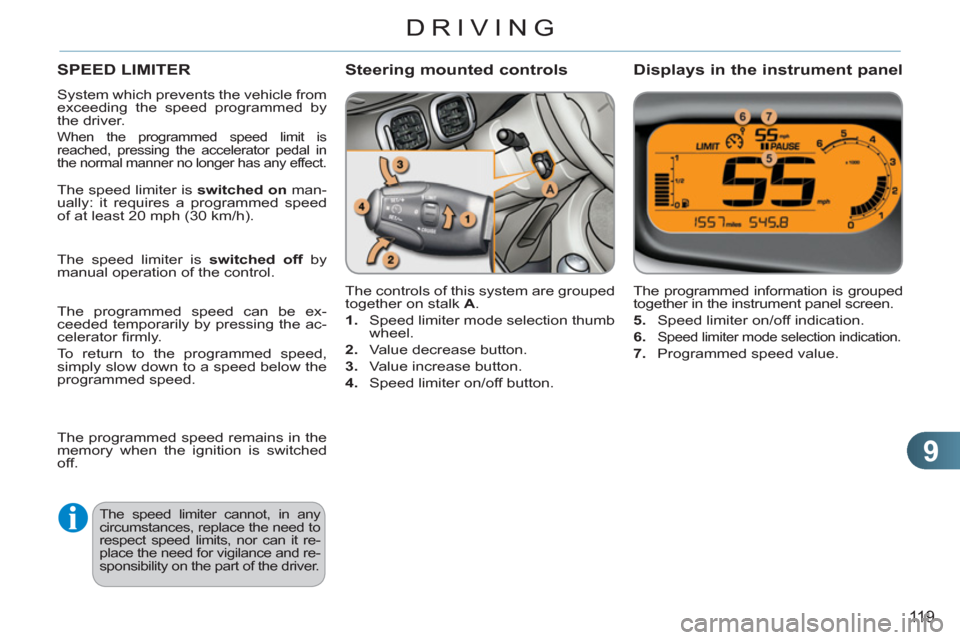
9
119
DRIVING
SPEED LIMITER
System which prevents the vehicle from
exceeding the speed programmed by
the driver.
When the programmed speed limit is
reached, pressing the accelerator pedal in
the normal manner no longer has any effect.
The controls of this system are grouped
together on stalk A
.
1.
Speed limiter mode selection thumb
wheel.
2.
Value decrease button.
3.
Value increase button.
4.
Speed limiter on/off button.
The programmed information is grouped
together in the instrument panel screen.
5.
Speed limiter on/off indication.
6.
Speed limiter mode selection indication.
7.
Programmed speed value.
Steering mounted controls
Displays in the instrument panel
The speed limiter cannot, in any
circumstances, replace the need to
respect speed limits, nor can it re-
place the need for vigilance and re-
sponsibility on the part of the driver.
The speed limiter is switched on
man-
ually: it requires a programmed speed
of at least 20 mph (30 km/h).
The speed limiter is switched off
by
manual operation of the control.
The programmed speed can be ex-
ceeded temporarily by pressing the ac-
celerator fi rmly.
To return to the programmed speed,
simply slow down to a speed below the
programmed speed.
The programmed speed remains in the
memory when the ignition is switched
off.
Page 123 of 244
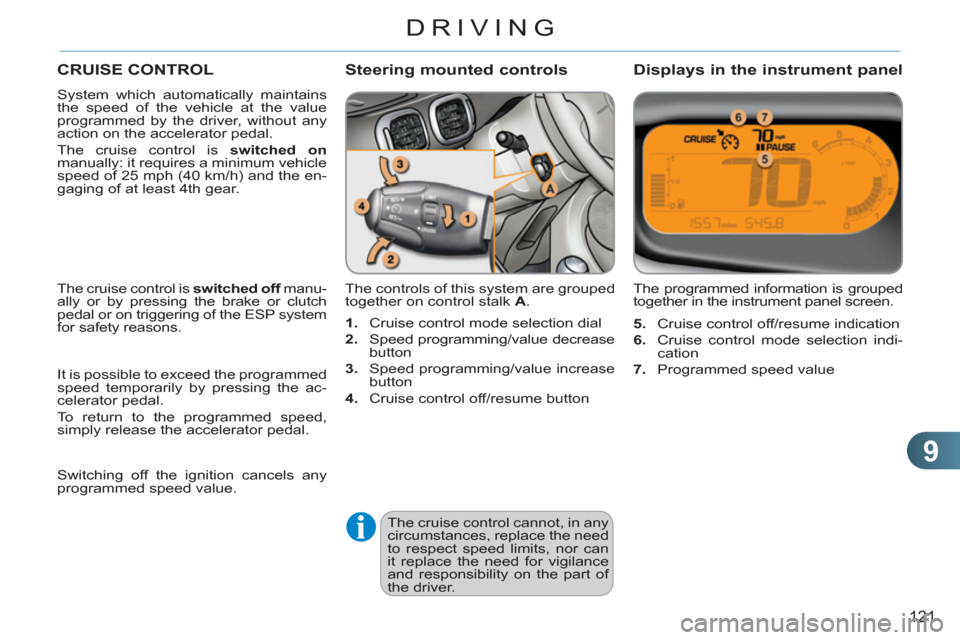
9
121
DRIVING
CRUISE CONTROL
System which automatically maintains
the speed of the vehicle at the value
programmed by the driver, without any
action on the accelerator pedal.
The cruise control is switched on
manually: it requires a minimum vehicle
speed of 25 mph (40 km/h) and the en-
gaging of at least 4th gear.
The controls of this system are grouped
together on control stalk A
. The programmed information is grouped
together in the instrument panel screen.
Steering mounted controls
Displays in the instrument panel
The cruise control cannot, in any
circumstances, replace the need
to respect speed limits, nor can
it replace the need for vigilance
and responsibility on the part of
the driver. The cruise control is switched off
manu-
ally or by pressing the brake or clutch
pedal or on triggering of the ESP system
for safety reasons.
It is possible to exceed the programmed
speed temporarily by pressing the ac-
celerator pedal.
To return to the programmed speed,
simply release the accelerator pedal.
Switching off the ignition cancels any
programmed speed value.
1.
Cruise control mode selection dial
2.
Speed programming/value decrease
button
3.
Speed programming/value increase
button
4.
Cruise control off/resume button
5.
Cruise control off/resume indication
6.
Cruise control mode selection indi-
cation
7.
Programmed speed value
Page 125 of 244
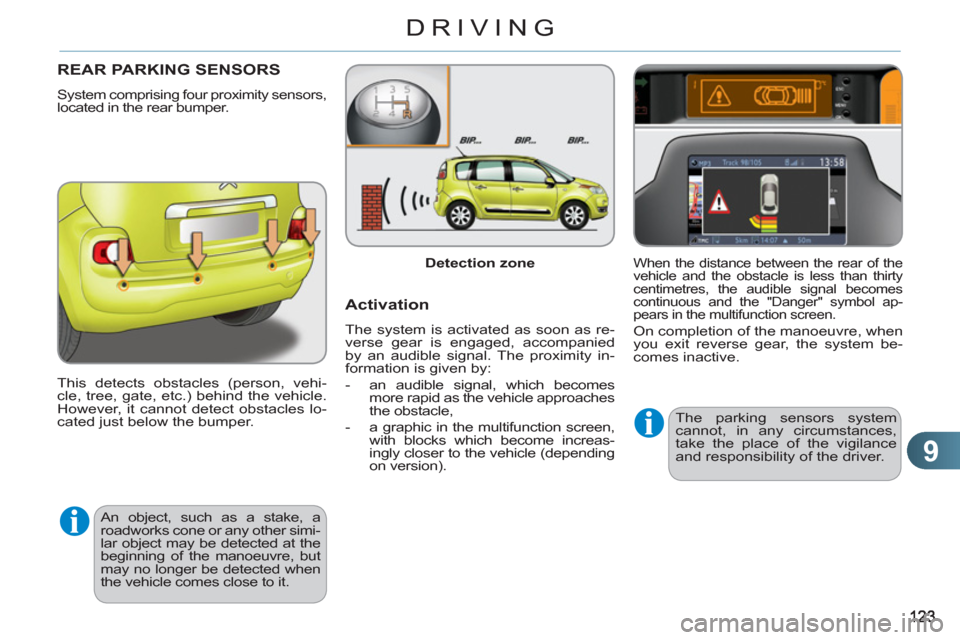
9
DRIVING
REAR PARKING SENSORS
System comprising four proximity sensors,
located in the rear bumper.
This detects obstacles (person, vehi-
cle, tree, gate, etc.) behind the vehicle.
However, it cannot detect obstacles lo-
cated just below the bumper.
An object, such as a stake, a
roadworks cone or any other simi-
lar object may be detected at the
beginning of the manoeuvre, but
may no longer be detected when
the vehicle comes close to it.
Activation
The system is activated as soon as re-
verse gear is engaged, accompanied
by an audible signal. The proximity in-
formation is given by:
- an audible signal, which becomes
more rapid as the vehicle approaches
the obstacle,
- a graphic in the multifunction screen,
with blocks which become increas-
ingly closer to the vehicle (depending
on version). The parking sensors system
cannot, in any circumstances,
take the place of the vigilance
and responsibility of the driver.
Detection zone
When the distance between the rear of the
vehicle and the obstacle is less than thirty
centimetres, the audible signal becomes
continuous and the "Danger" symbol ap-
pears in the multifunction screen.
On completion of the manoeuvre, when
you exit reverse gear, the system be-
comes inactive.
Page 132 of 244
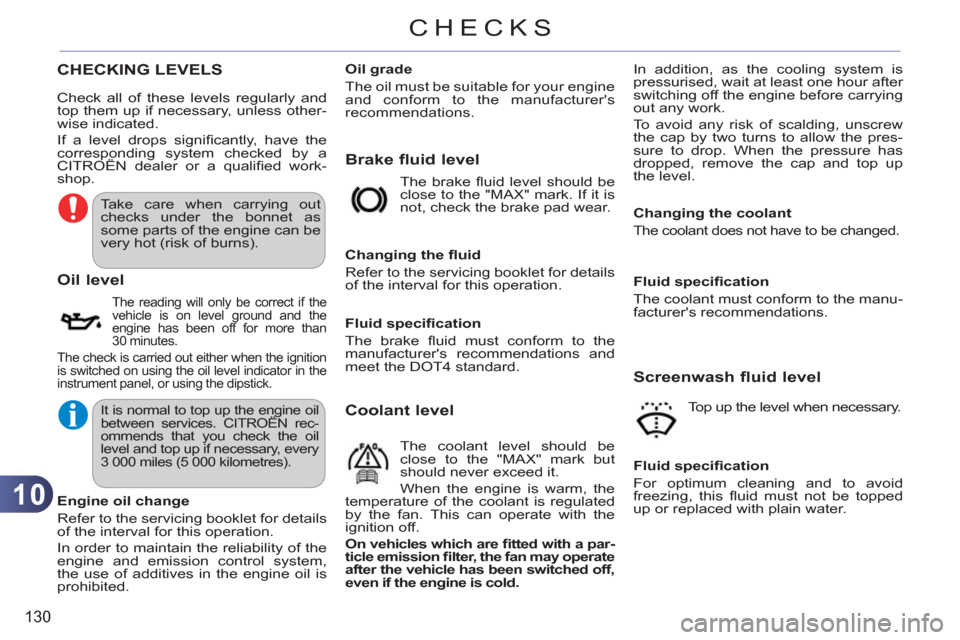
10
130
CHECKS
CHECKING LEVELS
Brake fluid level
Oil level
The reading will only be correct if the
vehicle is on level ground and the
engine has been off for more than
30 minutes.
The check is carried out either when the ignition
is switched on using the oil level indicator in the
instrument panel, or using the dipstick.
The brake fl uid level should be
close to the "MAX" mark. If it is
not, check the brake pad wear.
Changing the fl uid
Refer to the servicing booklet for details
of the interval for this operation.
Coolant level
The coolant level should be
close to the "MAX" mark but
should never exceed it.
When the engine is warm, the
temperature of the coolant is regulated
by the fan. This can operate with the
ignition off.
On vehicles which are fi tted with a par-
ticle emission fi lter, the fan may operate
after the vehicle has been switched off,
even if the engine is cold.
Fluid specifi cation
For optimum cleaning and to avoid
freezing, this fl uid must not be topped
up or replaced with plain water.
Engine oil change
Refer to the servicing booklet for details
of the interval for this operation.
In order to maintain the reliability of the
engine and emission control system,
the use of additives in the engine oil is
prohibited.
Oil grade
The oil must be suitable for your engine
and conform to the manufacturer's
recommendations.
Fluid specifi cation
The brake fl uid must conform to the
manufacturer's recommendations and
meet the DOT4 standard.
Fluid specifi cation
The coolant must conform to the manu-
facturer's recommendations.
Changing the coolant
The coolant does not have to be changed.
Screenwash fluid level
Check all of these levels regularly and
top them up if necessary, unless other-
wise indicated.
If a level drops signifi cantly, have the
corresponding system checked by a
CITROËN dealer or a qualifi ed work-
shop. In addition, as the cooling system is
pressurised, wait at least one hour after
switching off the engine before carrying
out any work.
To avoid any risk of scalding, unscrew
the cap by two turns to allow the pres-
sure to drop. When the pressure has
dropped, remove the cap and top up
the level.
Top up the level when necessary.
Take care when carrying out
checks under the bonnet as
some parts of the engine can be
very hot (risk of burns).
It is normal to top up the engine oil
between services. CITROËN rec-
ommends that you check the oil
level and top up if necessary, every
3 000 miles (5 000 kilometres).
Page 148 of 244
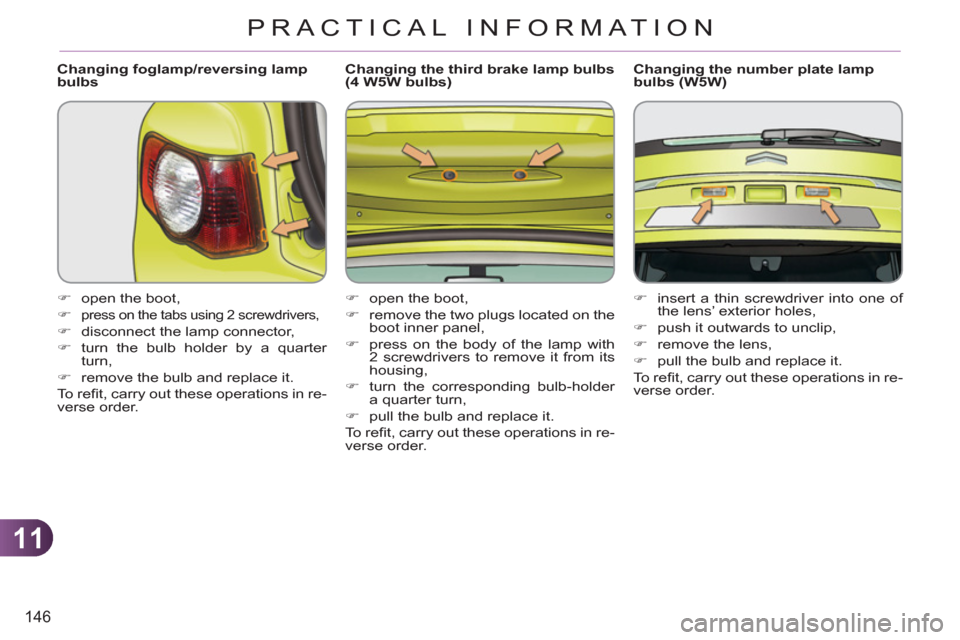
11
146
PRACTICAL INFORMATION
Changing foglamp/reversing lamp
bulbs
�)
open the boot,
�)
press on the tabs using 2 screwdrivers,
�)
disconnect the lamp connector,
�)
turn the bulb holder by a quarter
turn,
�)
remove the bulb and replace it.
To r efi t, carry out these operations in re-
verse order.
Changing the third brake lamp bulbs
(4 W5W bulbs)
�)
open the boot,
�)
remove the two plugs located on the
boot inner panel,
�)
press on the body of the lamp with
2 screwdrivers to remove it from its
housing,
�)
turn the corresponding bulb-holder
a quarter turn,
�)
pull the bulb and replace it.
To r efi t, carry out these operations in re-
verse order.
Changing the number plate lamp
bulbs (W5W)
�)
insert a thin screwdriver into one of
the lens’ exterior holes,
�)
push it outwards to unclip,
�)
remove the lens,
�)
pull the bulb and replace it.
To r efi t, carry out these operations in re-
verse order.
Page 150 of 244
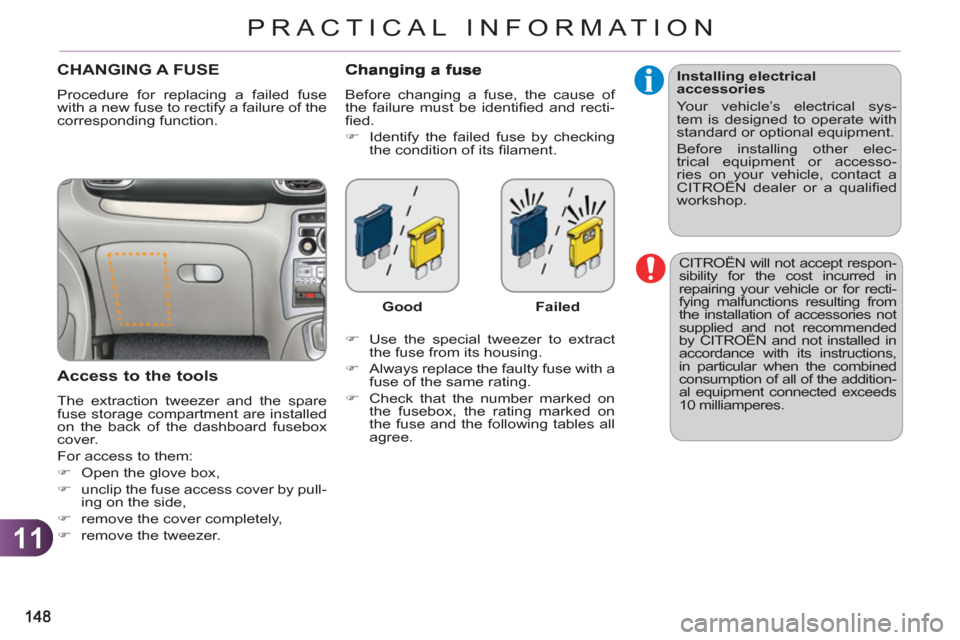
11
PRACTICAL INFORMATION
CITROËN will not accept respon-
sibility for the cost incurred in
repairing your vehicle or for recti-
fying malfunctions resulting from
the installation of accessories not
supplied and not recommended
by CITROËN and not installed in
accordance with its instructions,
in particular when the combined
consumption of all of the addition-
al equipment connected exceeds
10 milliamperes.
Installing electrical
accessories
Your vehicle’s electrical sys-
tem is designed to operate with
standard or optional equipment.
Before installing other elec-
trical equipment or accesso-
ries on your vehicle, contact a
CITROËN dealer or a qualifi ed
workshop.
CHANGING A FUSE
Procedure for replacing a failed fuse
with a new fuse to rectify a failure of the
corresponding function.
Access to the tools
The extraction tweezer and the spare
fuse storage compartment are installed
on the back of the dashboard fusebox
cover.
For access to them:
�)
Open the glove box,
�)
unclip the fuse access cover by pull-
ing on the side,
�)
remove the cover completely,
�)
remove the tweezer.
Before changing a fuse, the cause of
the failure must be identifi ed and recti-
fi ed.
�)
Identify the failed fuse by checking
the condition of its fi lament.
�)
Use the special tweezer to extract
the fuse from its housing.
�)
Always replace the faulty fuse with a
fuse of the same rating.
�)
Check that the number marked on
the fusebox, the rating marked on
the fuse and the following tables all
agree.
Good
Failed
Page 153 of 244
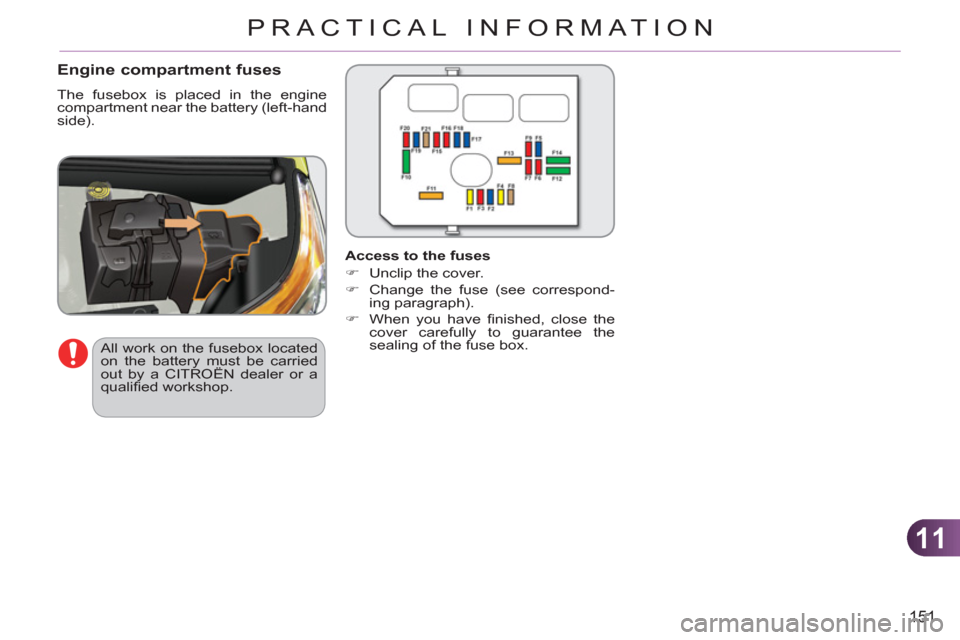
11
151
PRACTICAL INFORMATION
Engine compartment fuses
The fusebox is placed in the engine
compartment near the battery (left-hand
side).
All work on the fusebox located
on the battery must be carried
out by a CITROËN dealer or a
qualifi ed workshop.
Access to the fuses
�)
Unclip the cover.
�)
Change the fuse (see correspond-
ing paragraph).
�)
When you have fi nished, close the
cover carefully to guarantee the
sealing of the fuse box.
Page 154 of 244
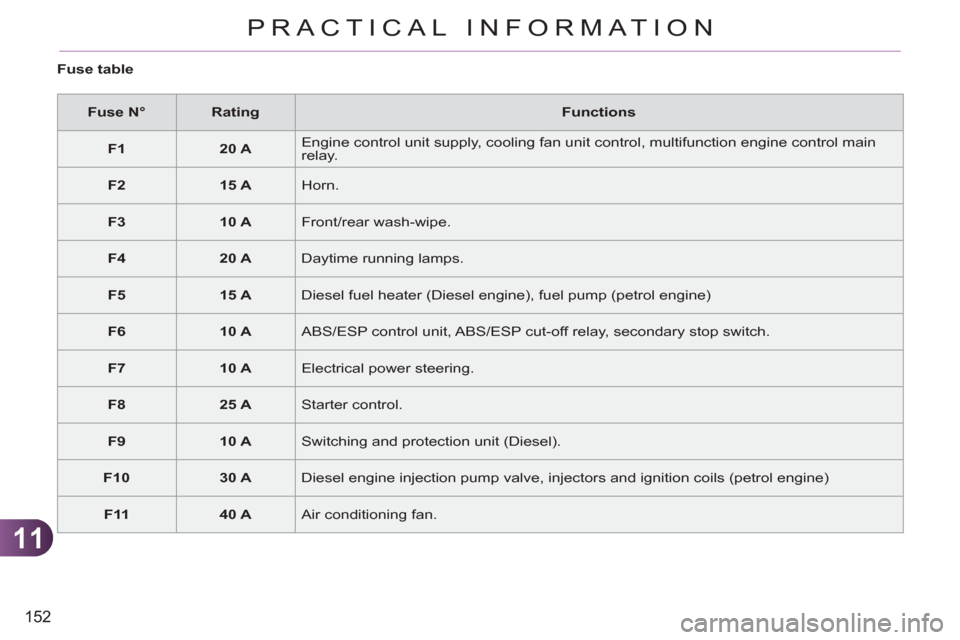
11
152
PRACTICAL INFORMATION
Fuse N°
Rating
Functions
F1
20 A
Engine control unit supply, cooling fan unit control, multifunction engine control main
relay.
F2
15 A
Horn.
F3
10 A
Front/rear wash-wipe.
F4
20 A
Daytime running lamps.
F5
15 A
Diesel fuel heater (Diesel engine), fuel pump (petrol engine)
F6
10 A
ABS/ESP control unit, ABS/ESP cut-off relay, secondary stop switch.
F7
10 A
Electrical power steering.
F8
25 A
Starter control.
F9
10 A
Switching and protection unit (Diesel).
F10
30 A
Diesel engine injection pump valve, injectors and ignition coils (petrol engine)
F11
40 A
Air conditioning fan.
Fuse table
Page 155 of 244
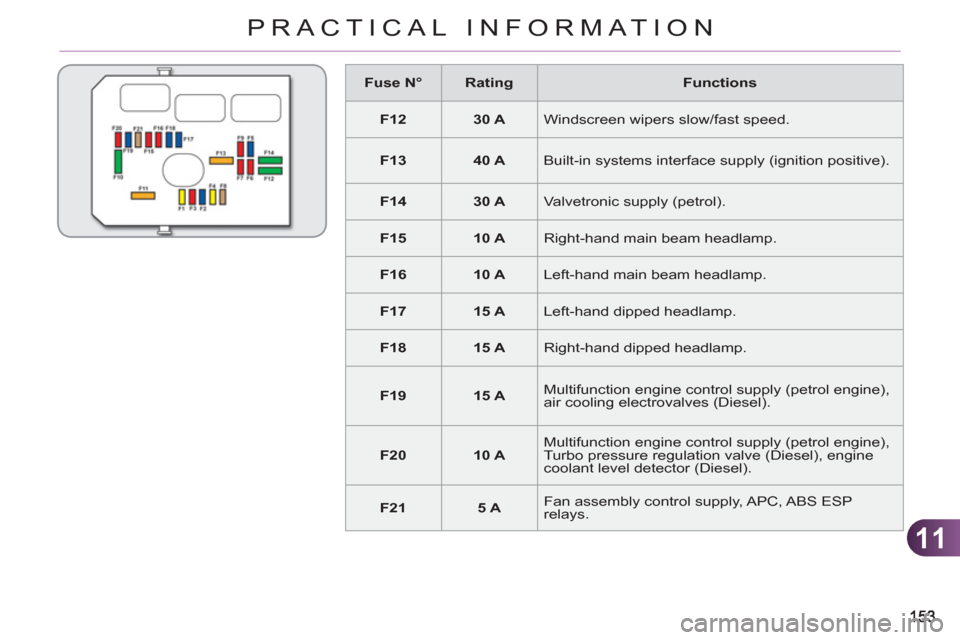
11
PRACTICAL INFORMATION
Fuse N°
Rating
Functions
F12
30 A
Windscreen wipers slow/fast speed.
F13
40 A
Built-in systems interface supply (ignition positive).
F14
30 A
Valvetronic supply (petrol).
F15
10 A
Right-hand main beam headlamp.
F16
10 A
Left-hand main beam headlamp.
F17
15 A
Left-hand dipped headlamp.
F18
15 A
Right-hand dipped headlamp.
F19
15 A
Multifunction engine control supply (petrol engine),
air cooling electrovalves (Diesel).
F20
10 A
Multifunction engine control supply (petrol engine),
Turbo pressure regulation valve (Diesel), engine
coolant level detector (Diesel).
F21
5 A
Fan assembly control supply, APC, ABS ESP
relays.
Page 156 of 244

11
154
PRACTICAL INFORMATION
Table of maxi-fuses
Fuse N°
Rating
Functions
MF1 *
60 A
Cooling fan assembly.
MF2 *
30 A
ABS/ESP control unit.
MF3 *
30 A
ABS/ESP control unit.
MF4 *
60 A
Built-in Systems Interface (BSI) supply.
MF5 *
60 A
Built-in Systems Interface (BSI) supply.
MF6 *
-
Not used.
MF7 *
-
Dashboard fusebox.
MF8 *
-
Not used.
*
The maxi-fuses provide additional protection for the electrical systems. All work on the maxi-fuses must be carried out by a
CITROËN dealer or a qualifi ed workshop.